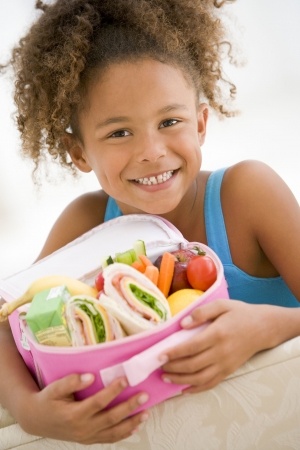While most kids are taking in all of the joys and excitement that summer has to offer, many parents have school looming in the back of their minds. Although every summer’s end is somewhat bittersweet, for many parents it is a relief to get the kids back on a schedule. On that same note, it’s a time when parents and caregivers may have a new vision to improve something in their children’s lives. Maybe this year there will be one less activity to avoid the all-too-common tendency to over-schedule our kids. Or perhaps a parent is dreaming up a way to avoid the frequent colds of last fall and winter. Whatever plans and changes are lurking around the corner, we have ideas for you!
Let’s start with nutrition. Packing healthy lunches for kids to be exact. I recently borrowed a book from the library called Feeding The Whole Family: Recipes for Babies, Young Children and Their Parents. I was especially drawn toward this book because the author, Cynthia Lair, shared that much of her learning about cooking with whole foods stemmed from her experience working the head chef at Bastyr University, which is one of the accredited Naturopathic medical school in the U.S.
Lair has fun, creative ideas that involve children in the kitchen. One of my favorites is called “Lively Lunch Boxes.” A Lunch Box Chart with three categories can help caregivers and parents create nutritious lunches that kids will eat and enjoy! If the child is five years old or older, have them select the food themselves from the kitchen since kids are more likely to eat something that they choose.
The first category is “growing foods,” which means a protein source. A growing food can be vegetarian or animal-based. Vegetarian examples include beans and rice, edamame with quinoia, burrito with mashed pinto beans and cheese, sesame noodles and tempeh bacon, marinated, sautéed tofu, or hummus with vegetable slices. Animal protein examples include fish, chicken, turkey or eggs. A kid may choose foods such as a hot dog (grass-fed, no nitrate), baked chicken strips, smoked salmon chunks, any leftover meat slices, turkey meatloaf or even a hard-boiled egg.
The second category is “fresh vegetables.” Adding fresh vegetables is always a great way to provide vitamins, minerals and enzymes in the child’s lunch. Cucumber slices, carrots or celery work well. Baked sweet potato, snap peas, steamed green beans or blanched broccoli are other great examples. The third category is “seasonal fruit.” A parent can pack strawberries, kiwi slices, fresh pineapple chunks or sliced apples with almond butter to name a few. Dried figs and apricots with cashews and sunflower seeds can be delicious also.
For the more adventurous child, add more daring selections in general. Maybe California rolls with salmon and avocado for the growing food, arame (sea vegetable) with cucumber slices for the vegetable and plums for the fruit. Whatever selections are made, this approach provides a framework to keep it healthy for the child!
While kids may not eat all of the healthy foods in the lunch, it’s a step in the right direction to have it packed and ready for them. It can help to pick a fun lunch box and include a colorful, cloth napkin and a note rather than a sugary snack. Omitting a dessert might be a good idea because sometimes kids eat that first and forget the rest of the lunch. Having that nutritious meal plays a key role in helping their attention span during afternoon classes, helping them have greater stamina in afterschool sports or gym class and keeping their skin clear. Rather that giving them a sugary drink, why not give them a thermos of herbal tea with honey or a mixture of cold herbal tea with soda water?
There are even more benefits of children having a healthy lunch. With childhood obesity, diabetes and ADHD on the rise in this country, the importance of instilling healthy eating habits in our children is paramount. I remember when I lived in Alaska and worked at a residential treatment center for emotionally disturbed teenagers. The kids went to school, slept and shared meals at the home. What saddened me was how almost every child who entered the program usually gained 20-30 pounds within three months of living there. Most of their foods were processed and very few whole foods were served. As if these kids didn’t have enough issues with self-esteem and moods! Here is a very convincing account of a positive situation where a school changed the eating style of the students and profound changes occurred with the student’s health and behavior.







